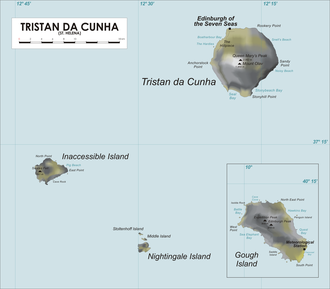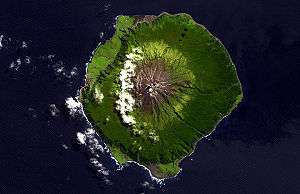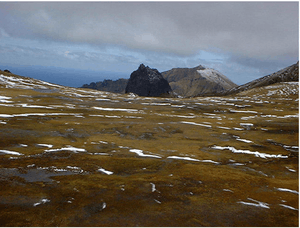Geography of Tristan da Cunha
Tristan da Cunha is an archipelago of five islands in the southern Atlantic Ocean, the largest of which is the island of Tristan da Cunha itself and the second-largest the remote bird haven Gough Island. It forms part of a wider territory called Saint Helena, Ascension and Tristan da Cunha which includes Saint Helena and Ascension Island.

Location and description

This archipelago, 1500 miles (2500 km) from the continents of Africa and South America, is one of the most remote inhabited places on earth. It consists of the following islands:
- the main island Tristan da Cunha and its surrounding islands
- Tristan da Cunha, the main island and largest (37°6′44″S 12°16′56″W) area: 98 square kilometres (38 sq mi)[1]
- Inaccessible Island area: 14 square kilometres (5.4 sq mi)
- Nightingale Islands area: 3.4 square kilometres (1.3 sq mi)
- Nightingale Island area: 3.2 square kilometres (1.2 sq mi)
- Middle Island area: 0.1 square kilometres (25 acres)
- Stoltenhoff Island area: 0.1 square kilometres (25 acres)
- Gough Island (Diego Alvarez) area: 68 square kilometres (26 sq mi) important as the largest undisturbed cool-temperate island habitat in the South Atlantic Ocean.
The main island is quite mountainous; the only flat area is the location of the capital, Edinburgh of the Seven Seas, on the northwest coast. The highest point is a volcano called Queen Mary's Peak 2,062 metres (6,765 ft); it is covered by snow in winter and is listed as an ultra prominent peak. Tristan da Cunha is thought to have been formed by a long-lived centre of upwelling magma called the Tristan hotspot.
The climate is marine cool-temperate with small temperature differences between summer and winter (11.3° - 14.5°) and between day and night. Sandy Point on the east coast is reputed to be the warmest and driest place on the island, being in the lee of the prevailing winds.
Flora

Even the smaller islands have some plant cover, with the larger ones dominated by ferns and moss. Flora on the archiplego includes many endemic species and many that have a broad circumpolar distribution in the South Atlantic and South Pacific Oceans. Thus many of the species that occur in Tristan da Cunha occur as far away as New Zealand. For example, the species Nertera depressa was first collected in Tristan da Cunha,[2] but has since been recorded in occurrence as far distant as New Zealand.[3]
Fauna
Tristan da Cunha is home to ocean-going species including subantarctic fur seal, the southern elephant seal and birds such as northern rockhopper penguins and macaroni penguins. The islands are important for their bird life both those established on the islands and breeding seabirds, of which twenty species nest on Gough Island alone. Important species include Tristan albatross, Tristan thrush, Tristan bunting, Gough bunting, Gough moorhen, Atlantic petrel, and the Inaccessible Island rail. There are no native reptiles, amphibians, freshwater fish, or land mammals.
Human settlement
Apart from Tristan da Cunha, which was settled as a base for whaling and sealing in the 18th century, the islands of the group are uninhabited except for a weather station on Gough Island belonging to South Africa. Fishing is still an important economic activity especially for crayfish and octopus but also the Tristan rock lobster (Jasus tristani). Gough Island has also been used as base for whaling and sealing but only ever temporarily. The islands do receive a small number of tourists.
Threats and preservation
Sheep and cattle have been introduced on Tristan da Cunha and their grazing, along with other human activity has caused damage to the island's ecosystems. Night fishing has caused the deaths of many seabirds as they crash into ships' lights.[4]
See also
References
- Rosenberg, Mark (6 March 2017). "Tristan da Cunha". ThoughtCo. Retrieved 5 January 2019.
- Linnean Society of London. 1906. The journal of the Linnean Society of London, Published by Academic Press for the Linnean Society of London., v. 37
- C. Michael Hogan. 2009. Crown Fern: Blechnum discolor, Globaltwitcher.com, ed. N. Stromberg Archived February 13, 2012, at the Wayback Machine
- Ryan, P. G. 1991. The impact of the commercial lobster fishery on seabirds at the Tristan da Cunha Islands, South Atlantic Ocean. Biological Conservation 57:339-350.
External links
- "Tristan Da Cunha-Gough Islands shrub and grasslands". Terrestrial Ecoregions. World Wildlife Fund.